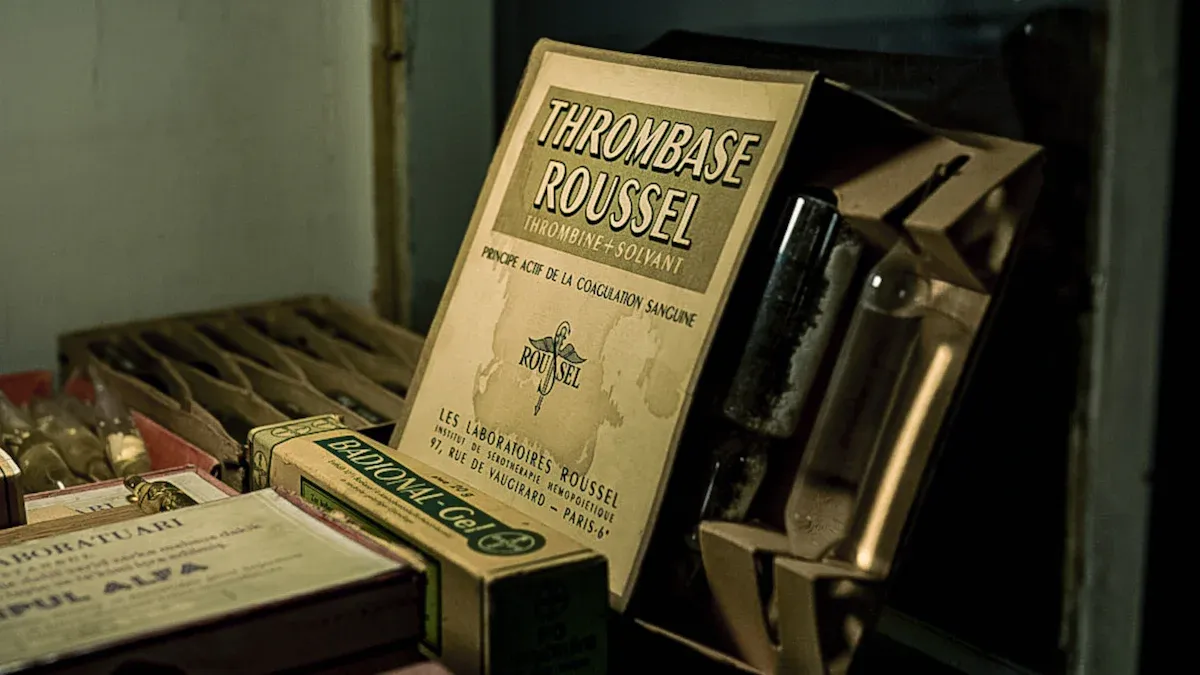Simple Steps to Preserve Your Helius Flashlight Battery Power

Your Helius flashlight is only as reliable as its batteries. Want to extend the lifespan of your flashlight? Start by treating your batteries right. Proper care ensures your flashlights stay dependable when you need them most. With a few simple habits, you can keep your Helius flashlight shining bright for years to come.
Key Takeaways
Pick good-quality batteries for your Helius flashlight. They give steady power and improve how it works, making it dependable when needed.
Keep batteries in a cool, dry spot, away from heat or cold. Storing them right avoids harm and keeps them ready to use.
Check your flashlight and batteries often for damage or wear. Finding problems early can stop dangers and make batteries last longer.
Choosing the Right Batteries

Why High-Quality Batteries Matter
Not all batteries are created equal. Choosing high-quality batteries ensures your Helius flashlight performs at its best. These batteries provide consistent power, which means your flashlight stays bright when you need it most. Low-quality options might save you money upfront, but they often drain faster and can even damage your flashlight over time. Investing in high-quality batteries is one of the best practices for battery health and long-term reliability.
Ensuring Compatibility with Your Helius Flashlight
Using the right batteries for your Helius flashlight is crucial. Always check the manufacturer’s recommendations to ensure battery compatibility. Mismatched batteries can lead to poor performance or even permanent damage. For outdoor or emergency use, lithium-ion batteries are a great choice. They perform well in extreme temperatures and have a longer shelf life compared to alkaline options. Remember, the right batteries keep your flashlight dependable in any situation.
Rechargeable Batteries vs. Disposable Batteries
When it comes to rechargeable flashlights, you have two main options: rechargeable batteries or disposable ones. Rechargeable batteries offer long-term savings, reducing costs by over $200 in the first year despite a slightly higher upfront price. They’re also eco-friendly, minimizing landfill waste and supporting sustainability efforts. Plus, rechargeable flashlights often deliver consistent brightness and can be charged via USB or car chargers, making them convenient for daily use.
Flashlight Type | Average Cost Difference | Long-term Savings |
|---|---|---|
Rechargeable | $10 - $15 more | Over $200 in the first year |
Disposable | Lower upfront cost | Higher battery costs |
However, rechargeable batteries have a limited lifespan, typically lasting 300 to 1,000 cycles. They also require access to power for charging, which can be challenging during power outages. Disposable batteries, on the other hand, are better for emergency kits due to their longer shelf life and immediate usability. Consider your needs and choose the option that works best for you.
Rechargeable batteries reduce waste and prevent harmful chemicals like mercury and cadmium from polluting the environment. They’re a sustainable choice for eco-conscious users.
Proper Storage and Maintenance
Storing Batteries in Optimal Conditions
Storing your flashlight batteries correctly can make a big difference in their performance. Batteries don’t like extreme temperatures. Avoid exposing them to anything below -4° F or above 122° F for long periods. These conditions can drain their efficiency and shorten their lifespan. Instead, keep them in a room-temperature environment. A cool, dry place away from direct sunlight works best. Moisture can damage battery cells, so avoid storing them in damp areas like basements or bathrooms. Proper storage ensures your batteries stay ready when you need them most.
Preventing Battery Leakage and Corrosion
Battery leakage and corrosion can ruin your flashlight. Luckily, you can prevent this with a few simple steps.
Remove batteries from your flashlight if you’re not using it for a while.
Store spare batteries in a ziplock bag, especially if they’re part of an emergency kit. Check them periodically for leaks or expiration dates.
Never mix different types, brands, or ages of batteries in the same flashlight. This can cause uneven discharge and increase the risk of leakage.
Taking these precautions will help prolong the lifespan of your flashlight batteries and keep your flashlight in top shape.
Regular Maintenance for Extended Lifespan
Regular maintenance is key to maximizing the lifespan of your batteries. Inspect your flashlight at least once a month. Look for signs of corrosion or damage on the batteries and their contacts. Before heading out for outdoor activities or emergencies, give your flashlight a quick check. Clean dirty or corroded contacts with a cotton swab dipped in rubbing alcohol. This ensures proper conductivity and prevents power loss. Regular cleaning of your flashlight and battery surfaces also helps prevent dirt buildup. These small steps go a long way in keeping your flashlight reliable.
Tip: If you’re using rechargeable batteries, fully discharge them before recharging to avoid the memory effect. Use the right charger and avoid overcharging to extend the lifespan of your batteries.
Efficient Flashlight Usage

Using Energy-Saving Features
Modern flashlights, including your Helius flashlight, come packed with energy-saving features that help conserve battery life. Using these features can make a big difference in extending battery life and ensuring optimal performance. Here are some of the most efficient options you should look for:
Rechargeable flashlights eliminate the need for extra batteries and offer longer runtimes.
Solar-powered models charge through USB or solar panels, making them perfect for off-grid adventures.
AI-driven lighting adjusts brightness automatically based on your surroundings, saving power.
Dual-functionality designs can even charge your devices, doubling as power banks.
By taking advantage of these features, you can use the flashlight efficiently while reducing waste and saving money on batteries.
Avoiding Overuse of High Power Modes
High power modes might seem tempting when you need maximum brightness, but they can drain your flashlight batteries quickly. Instead, stick to lower brightness settings for everyday tasks. Reserve high power modes for emergencies or situations where you need extra light. Many rechargeable flashlights also include adjustable brightness levels, so you can choose the right setting for your needs. This simple habit not only conserves battery life but also ensures your flashlight is ready when you need it most.
Tip: Use the medium or low setting for tasks like reading or walking at night. It’s bright enough for most activities and helps extend battery life.
Minimizing Frequent On-Off Cycles
Turning your flashlight on and off repeatedly can waste energy and reduce the lifespan of your rechargeable batteries. Instead, keep the flashlight on at a consistent brightness level when you’re using it. If you only need light for a short moment, consider using the flashlight’s momentary-on feature, if available. This feature allows you to briefly activate the light without fully turning it on. Small adjustments like this can go a long way in extending battery life and maintaining optimal performance.
Remember, proper charging techniques are just as important as usage habits. Avoid overcharging your rechargeable flashlights to prevent damage and ensure long-term reliability.
Common Mistakes to Avoid
Mixing Different Types of Batteries
Mixing different types of batteries in your flashlight might seem harmless, but it can lead to serious problems. Here’s why you should avoid it:
Voltage Differences: Batteries with varying voltage levels can damage your flashlight or even cause fire hazards.
Capacity Mismatch: Using batteries with different capacities leads to uneven discharge, which can cause overheating.
Discharge Rates: Different chemistries result in inefficient energy use and safety risks.
Chemical Incompatibility: Mixing chemistries may trigger dangerous reactions, like leakage or explosions.
Reduced Performance: Your flashlight might shut down unexpectedly due to inconsistent power.
Safety Hazards: Electrical issues and fires become more likely when batteries are mixed.
Warranty Voiding: Manufacturers often void warranties if you mix battery types.
Stick to one type of battery for your flashlight to avoid these risks. It’s a simple step that ensures safety and keeps your flashlight running smoothly.
Ignoring Signs of Battery Wear or Damage
Damaged or worn-out batteries can harm your flashlight and pose safety risks. Always inspect your flashlight batteries for signs of wear, like corrosion, leaks, or bulging. If you notice any of these, handle the batteries carefully. Work in a well-ventilated area to avoid inhaling harmful fumes. Keep children and pets away, and never touch leaking material with bare hands. Use tools or gloves instead.
Dispose of damaged batteries responsibly. Many local recycling programs accept used batteries. Never throw them in the trash, as they can leak harmful chemicals into the environment. Regular checks and proper disposal protect both your flashlight and the planet.
Using Incompatible or Low-Quality Batteries
Using incompatible or low-quality batteries might save you money upfront, but it’s not worth the risk. Low-quality batteries often drain faster and can leak, damaging your flashlight. Incompatible batteries may not fit properly or provide the correct voltage, leading to poor performance or permanent damage.
Always choose high-quality batteries that match your flashlight’s specifications. Rechargeable flashlights work best with rechargeable batteries designed for their specific needs. Avoid overcharging them to extend their lifespan. Following these best practices for battery health ensures your flashlight stays reliable and efficient.
Taking care of your Helius flashlight batteries doesn’t have to be complicated. By choosing the right batteries, storing them in a cool, dry place, and performing regular inspections, you can extend the lifespan of your flashlight. Don’t forget to use the flashlight efficiently by avoiding high-power modes and frequent on-off cycles. Small habits like engaging the lockout feature and checking for overheating ensure optimal performance. Start applying these tips today to keep your flashlights reliable and ready for any situation.
FAQ
How often should you replace flashlight batteries?
Replace batteries when you notice dim light or reduced runtime. For emergency kits, swap them every 6-12 months to ensure reliability.
Can you leave rechargeable batteries in the flashlight?
Avoid leaving rechargeable batteries inside for long periods. They may overheat or leak. Remove them if you’re not using the flashlight for weeks.
What’s the best way to clean battery contacts?
Use a cotton swab dipped in rubbing alcohol. Gently clean the contacts to remove dirt or corrosion. Let them dry completely before reinserting batteries.
Tip: Regular cleaning keeps your flashlight performing at its best!
See Also
Key Strategies for Maintaining Your Flashlight Effectively
Boost Your Flashlight's Battery Life with These Helpful Tips
A Comprehensive Guide to Properly Cleaning Your Flashlight
